OFFSHOREART.CO
ARTICLES
Dynamic Infrastructure: Putting the Murky Coffin Imaginary of the Freeport to Rest
The Offshored Art World: Freeport Fictions
De-figured Monument
Dynamic Infrastructure:
Putting the Murky Coffin Imaginary of the Freeport to Rest
Countries have believed that freeports are a fast track to a more mature and sustainable art market. This definition of a more “mature” art market in the eyes of the State would be a loosely regulated market that was regulated enough to mitigate art smuggling and fraud, and ensure ‘validated’ value through the contract and other legal levers that the State could provide to attract global capital. As is evident in an interview with China Daily in 2014, Wang Yudong, director of the art trade center at the Beijing Culture Free Port would claim "We have mapped out a global free-port strategy. Our aim is to build an art free-port network in Asia.” Facilitated by state partners from Geneva, to Singapore, to Luxembourg, to Germany, to Paris to the state affiliated Beijing Gehua Cultural Development Group of the Beijing Freeport of Culture, freeports affiliated with the company Le Freeport or their related companies such as Asia Heritage Singapore, Euroasia Investment SA or Natural Le Coultre, are rapidly forming a new infrastructure and network of freezone spaces for the storage and movement of art and luxury goods.
Although each freeport varies slightly in terms of its individual jurisdictional arrangement with the State it exists both within and on the cusp of, freeports are special customs areas, or small customs territories, in which customs regulations are generally less strict, or there are no customs duties and/or controls for trans-shipment. This special status has, to no surprise, led them to be an object of imagination and curiosity in the art world, with big names and institutions such as Hito Steyerl and E-flux presenting visions and spectacular reports of the freeport an obscuring mechanism for the elite, and the freeport as a speculative storage hub for accumulating value. While there is no doubt that freeports enable value creating mechanisms, not through any physical operation but rather through a consolidated network of systems and associations, the static view of the free port as vaulted private bank hiding away and accruing value in assets such as art is a mis-representation of the freeport’s complexity as a dynamic infrastructural network. Such simplistic visions of warehouses as magic boxes is a product of a desire to fetishizing the freeport as an almost mythical space of abstract capitalism that in reality is less confounding than the mainstream narrative like the 2013 Economist article, ‘Freeport: Über-warehouses for the ultra-rich’, would have us believe (...)
Although each freeport varies slightly in terms of its individual jurisdictional arrangement with the State it exists both within and on the cusp of, freeports are special customs areas, or small customs territories, in which customs regulations are generally less strict, or there are no customs duties and/or controls for trans-shipment. This special status has, to no surprise, led them to be an object of imagination and curiosity in the art world, with big names and institutions such as Hito Steyerl and E-flux presenting visions and spectacular reports of the freeport an obscuring mechanism for the elite, and the freeport as a speculative storage hub for accumulating value. While there is no doubt that freeports enable value creating mechanisms, not through any physical operation but rather through a consolidated network of systems and associations, the static view of the free port as vaulted private bank hiding away and accruing value in assets such as art is a mis-representation of the freeport’s complexity as a dynamic infrastructural network. Such simplistic visions of warehouses as magic boxes is a product of a desire to fetishizing the freeport as an almost mythical space of abstract capitalism that in reality is less confounding than the mainstream narrative like the 2013 Economist article, ‘Freeport: Über-warehouses for the ultra-rich’, would have us believe (...)
The Offshored Art World:
Freeport Fictions
http://artnews.lt/ofsorinis-meno-pasaulis-isgalvoti-laisvojo-uosto-pasakojimai-36821
Defigured Monument
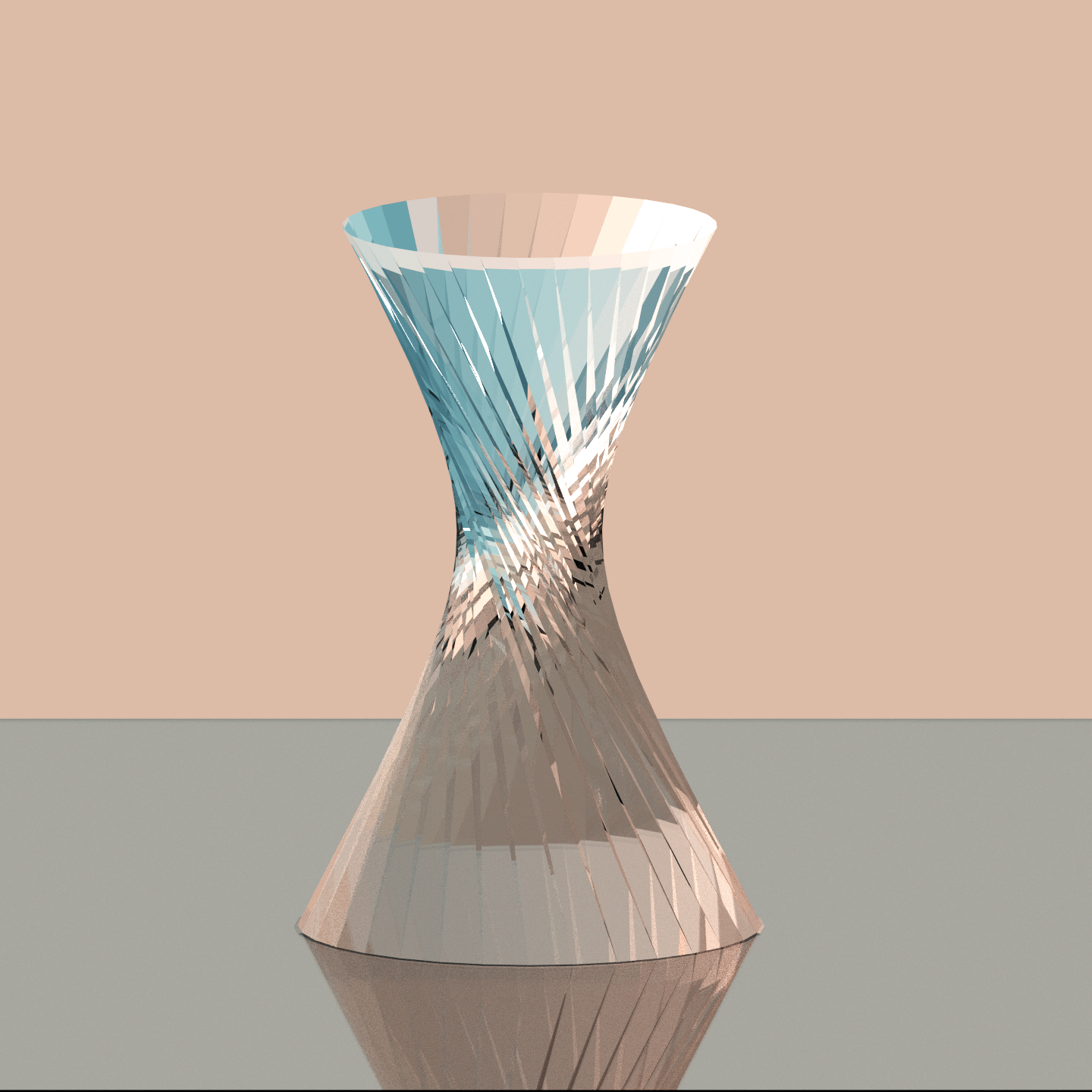
ONLINE
Offshoring and Virtual Infrastructures
Wednesday April 29th 2015
3-5pm EST
Incorporating Offshore:
The stakes of going offshore for art
Thursday April 30th 2015
3-5pm EST
EVENT 1: April 29th 2015, 3-5pm EST
Offshoring and Virtual Infrastructures
The development of offshore finance has often been attributed to a dependent and simultaneous development of the World Wide Web based on the early iteration of the web mapped through the global infrastructure of the telegraph, and telecommunication nodes of cable and wireless. As new technologies emerged, telegraph links were upgraded, moving from telephone trunk links to fibre optic cables and submarine networks. This process was highly intertwined with territorial, military, and economic interests.
Financial firms looking to establish branches and subsidiaries outside sovereign oversight would move offshore jurisdictions to specific locations connected and serviced by this infrastructure, enabling increased mobility, speed, and efficiency. In similar ways, the development of offshore data havens for the storage, maintenance, and facilitation of the virtual realities of communications technologies across national jurisdictions has been enabled by inherited market and economic structures that make land, labor, and legal structures more conducive in a specific country for the establishment of offshore offices or subsidiary operations for large international corporations.
This panel brings together a series of artists, theorists, and specialists to discuss the relationship of global infrastructures of the web and finance in the emergence of a culture of the offshore and how this has redefined cultural practice in terms of our relationship and autonomy as consumers/produces in a global economy.
Financial firms looking to establish branches and subsidiaries outside sovereign oversight would move offshore jurisdictions to specific locations connected and serviced by this infrastructure, enabling increased mobility, speed, and efficiency. In similar ways, the development of offshore data havens for the storage, maintenance, and facilitation of the virtual realities of communications technologies across national jurisdictions has been enabled by inherited market and economic structures that make land, labor, and legal structures more conducive in a specific country for the establishment of offshore offices or subsidiary operations for large international corporations.
This panel brings together a series of artists, theorists, and specialists to discuss the relationship of global infrastructures of the web and finance in the emergence of a culture of the offshore and how this has redefined cultural practice in terms of our relationship and autonomy as consumers/produces in a global economy.
Deborah Cowen teaches in the Department of Geography at the University of Toronto. Her research explores the role of organized violence in shaping intimacy, space, and citizenship. Cowen is the author of The Deadly Life of Logistics: Mapping Violence in Global Trade, Military Workfare: The Soldier and Social Citizenship in Canada, co-editor with Emily Gilbert, of War, Citizenship, Territory. Cowen edits the Geographies of Justice and Social Transformation book series at UGA Press, the journal Environment and Planning D: Society and Space, and serves on the board of the Groundswell Community Justice Trust Fund.
Meredith Lackey is a filmmaker and artist, whose research documents the political and economic relationships between business, states and global infrastructure through the laying of fiber optic cables. v
Meredith Lackey is a filmmaker and artist, whose research documents the political and economic relationships between business, states and global infrastructure through the laying of fiber optic cables. v
Bill Maurer is Dean of Social Science and Professor of Anthropology and Law at the University of California, Irvine. Maurer is a cultural anthropologist who conducts research on law, property, money and finance, focusing on the technological infrastructures and social relations of exchange and payment. Maurer has been involved in curatorial work more directly associated with his research, represented most recently in an ongoing exhibit on the past, present and future of money at the British Museum. More information can be found at http://faculty.sites.uci.edu/wmmaurer/
Yuri Pattison is an Irish multimedia artist based in London who studies ways in which the virtual world permeates material reality. Mastering a huge variety of media, his work often uses different devices to explore the strengths and limits of digital communication. Pattison is the current recipient of the Chisenhale Gallery Create Residency 2014-16. Recent solo exhibitions include Free Traveller Cell Projects, London (2014); Colocation, Time Displacement, Minibar, Stockholm, Sweden (2014); and e ink pearl memory, Arcadia_Missa, London, UK (2012). Selected group exhibitions include The Weight of Data, Tate Britain, London, UK (2015), The Future of Memory, Kunsthalle Wien, Austria (2015); Private Settings, Museum of Modern Art, Warsaw, Poland (2014); Snow Crash, Banner Repeater, London, UK (2014); and Objectness, Outpost, Norwich, UK (2013). His work can be found via www.yuripattison.com
Yuri Pattison is an Irish multimedia artist based in London who studies ways in which the virtual world permeates material reality. Mastering a huge variety of media, his work often uses different devices to explore the strengths and limits of digital communication. Pattison is the current recipient of the Chisenhale Gallery Create Residency 2014-16. Recent solo exhibitions include Free Traveller Cell Projects, London (2014); Colocation, Time Displacement, Minibar, Stockholm, Sweden (2014); and e ink pearl memory, Arcadia_Missa, London, UK (2012). Selected group exhibitions include The Weight of Data, Tate Britain, London, UK (2015), The Future of Memory, Kunsthalle Wien, Austria (2015); Private Settings, Museum of Modern Art, Warsaw, Poland (2014); Snow Crash, Banner Repeater, London, UK (2014); and Objectness, Outpost, Norwich, UK (2013). His work can be found via www.yuripattison.com
EVENT 2: April 30th 2015, 3-5pm EST
Incorporating Offshore: The stakes of going offshore for art
The offshore is a concept that underpins the institutional life of exchange in our current era of globalism. Often defined as strategy of maintaining autonomy and growing personal wealth, it is a concept that represents expanded cycles of capital flows often held to traverse the practices of state sovereignty.
Mired in a sense of the geopolitical sublime, the offshore is a complex, overwhelming, and inter-connective tissue to be teased out and worked through in order to find nodes, sources, and products. As more artists increasingly represent the offshore through engaging its strategies and devices and more art organizations increasingly go offshore for long-term sustainability as international entities, how do we take stock and make sense of the offshore culturally and aesthetically? How effective are strategies and narratives based on creating obscurity or clarity in revealing or complicating the structures of power, control, and autonomy that the offshore enables? Does art and culture, in modeling these flows of exchange, provide an analogy or case study for apprehending the offshore?
This panel brings together artists, theorists, and specialists invested in studying offshore systems of finance to understand the stakes of the offshore as a term, paradigm, and culture, as it applies to the art world and its discourses.
Mired in a sense of the geopolitical sublime, the offshore is a complex, overwhelming, and inter-connective tissue to be teased out and worked through in order to find nodes, sources, and products. As more artists increasingly represent the offshore through engaging its strategies and devices and more art organizations increasingly go offshore for long-term sustainability as international entities, how do we take stock and make sense of the offshore culturally and aesthetically? How effective are strategies and narratives based on creating obscurity or clarity in revealing or complicating the structures of power, control, and autonomy that the offshore enables? Does art and culture, in modeling these flows of exchange, provide an analogy or case study for apprehending the offshore?
This panel brings together artists, theorists, and specialists invested in studying offshore systems of finance to understand the stakes of the offshore as a term, paradigm, and culture, as it applies to the art world and its discourses.
Angus Cameron is a Senior Lecturer in Spatial Organisations at the University of Leicester. His primary research interests address the broad themes of spatiality, representation, and performance. He has a particular focus on the construction of 'xenospaces' - fictional but functional spaces of exteriority, ambiguity, and indeterminacy. Empirically this embraces topics of money, offshore finance, boundaries, taxation, cartography, discourses of inclusion/exclusion/exception, and visual semiotics. Since 2008, Cameron has extended his academic work by acting as 'spokesperson' for Swedish performance artists goldin+senneby on their ongoing project Headless and through collaborations with other artists and curators. As part of the panel, Cameron will represent the goldin+senneby and their project Headless.
Marianne Heier is an artist that lives and works in Oslo. In her projects, Heier often explores specific institutions ‘from the inside’. Her projects can be seen as situated within an institution-critical artistic praxis; but Heier’s critique from the inside is more often the result of personal engagement, motivated by personal, lived experience. She will be discussing her project Surplus, shown at Bergen Kunsthall in 2012. Surplus is particularly invested in overlaps and incompatibilities between financial and cultural capital.
Marianne Heier is an artist that lives and works in Oslo. In her projects, Heier often explores specific institutions ‘from the inside’. Her projects can be seen as situated within an institution-critical artistic praxis; but Heier’s critique from the inside is more often the result of personal engagement, motivated by personal, lived experience. She will be discussing her project Surplus, shown at Bergen Kunsthall in 2012. Surplus is particularly invested in overlaps and incompatibilities between financial and cultural capital.
Nathan Newman is a New York based lawyer and trustee of the Bronx Museum. Newman will speak to offshore structures and their utility for the individual and art organization. His work has been published in Forbes, Bloomberg, and Politix.
Nick Srnicek is the author of Inventing the Future (Verso, 2015 with Alex Williams) and the author of Postcapitalist Technologies (Polity, 2016). As part of the panel, he will present Seeing Global Markets. In an age of increased complexity and expanding global finance, this talk will look at a variety of ways in which these invisible entities are rendered visible and manipulable in practice.
Nick Srnicek is the author of Inventing the Future (Verso, 2015 with Alex Williams) and the author of Postcapitalist Technologies (Polity, 2016). As part of the panel, he will present Seeing Global Markets. In an age of increased complexity and expanding global finance, this talk will look at a variety of ways in which these invisible entities are rendered visible and manipulable in practice.
Index
Singapore
Presentation:
'Freeports, the Art World and Virtual Proxies’,
Grey Projects,
19 October 2015
Presentation:
The Singapore Freeport as
Schrödinger’s Cat Freeport, Asia Research Institute (ARI) Conference, 17-18 March 2016
Art Capital Reading Group
Online
Google+ Conferences
"Offshoring and Virtual Infrastructures" and "Incorporating Offshore: The Stakes of going Offshore for Art"
29-30 April 2015
Articles
Dynamic Infrastructure: Putting the Murky Coffin Imaginary of the Freeport to Rest (Finance and Society)
The Offshored Art World: Freeport Fictions
De-figured Monument
NEW YORK
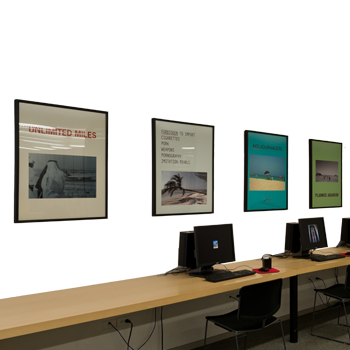
ROUNDTRIPPING
Selections from the Marieluise Hessel Collection
and CCS Bard Special Collections
CURATED BY KATHLEEN DITZIG AND ROBIN LYNCH
29 April 2015 - 30 April 2015
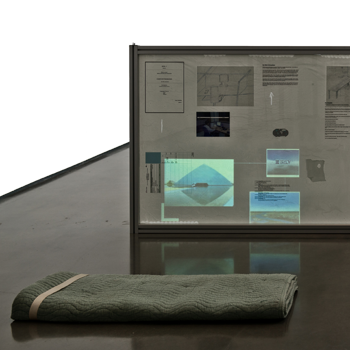
On Sweat, Paper, and Porcelain
CURATED BY KATHLEEN DITZIG
29 March 2015 - 3 May 2015
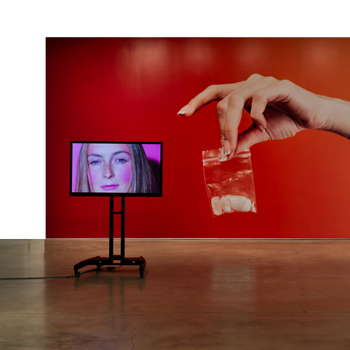
Incorporate Me
CURATED BY ROBIN LYNCH
29 March 2015 - 3 May 2015
Roundtripping: Selections from the
Marieluise Hessel Collection
and CCS Bard Special Collections

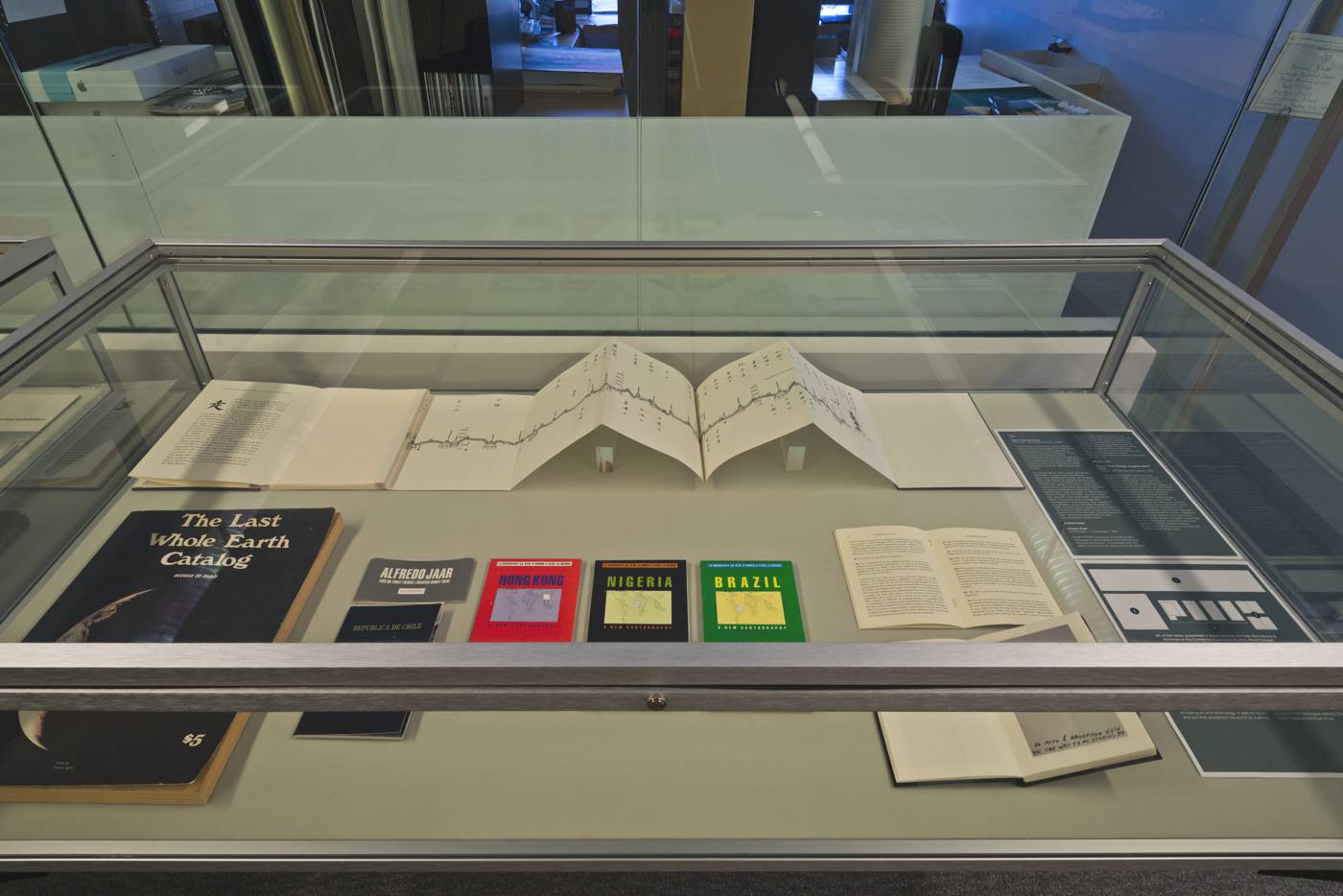
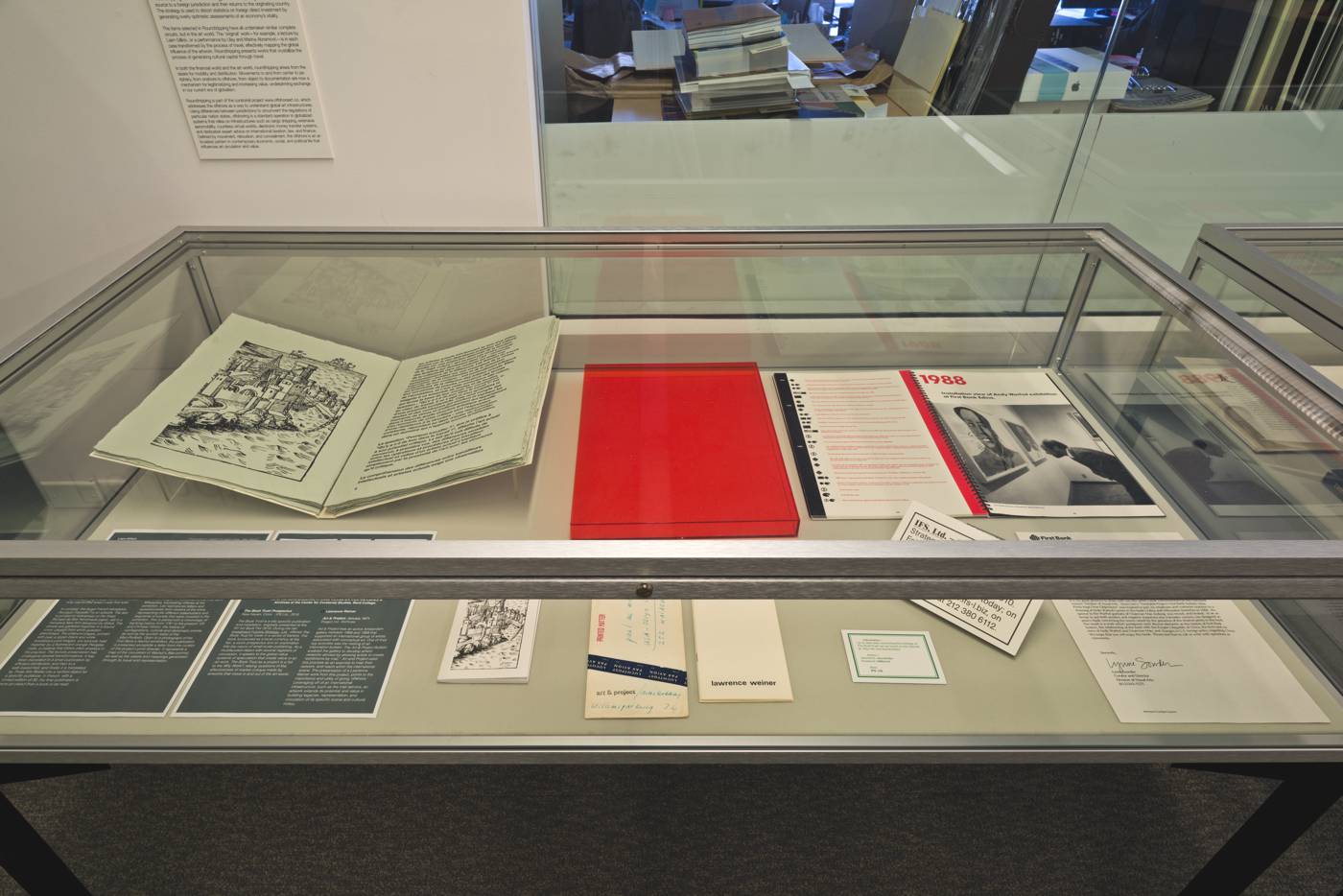
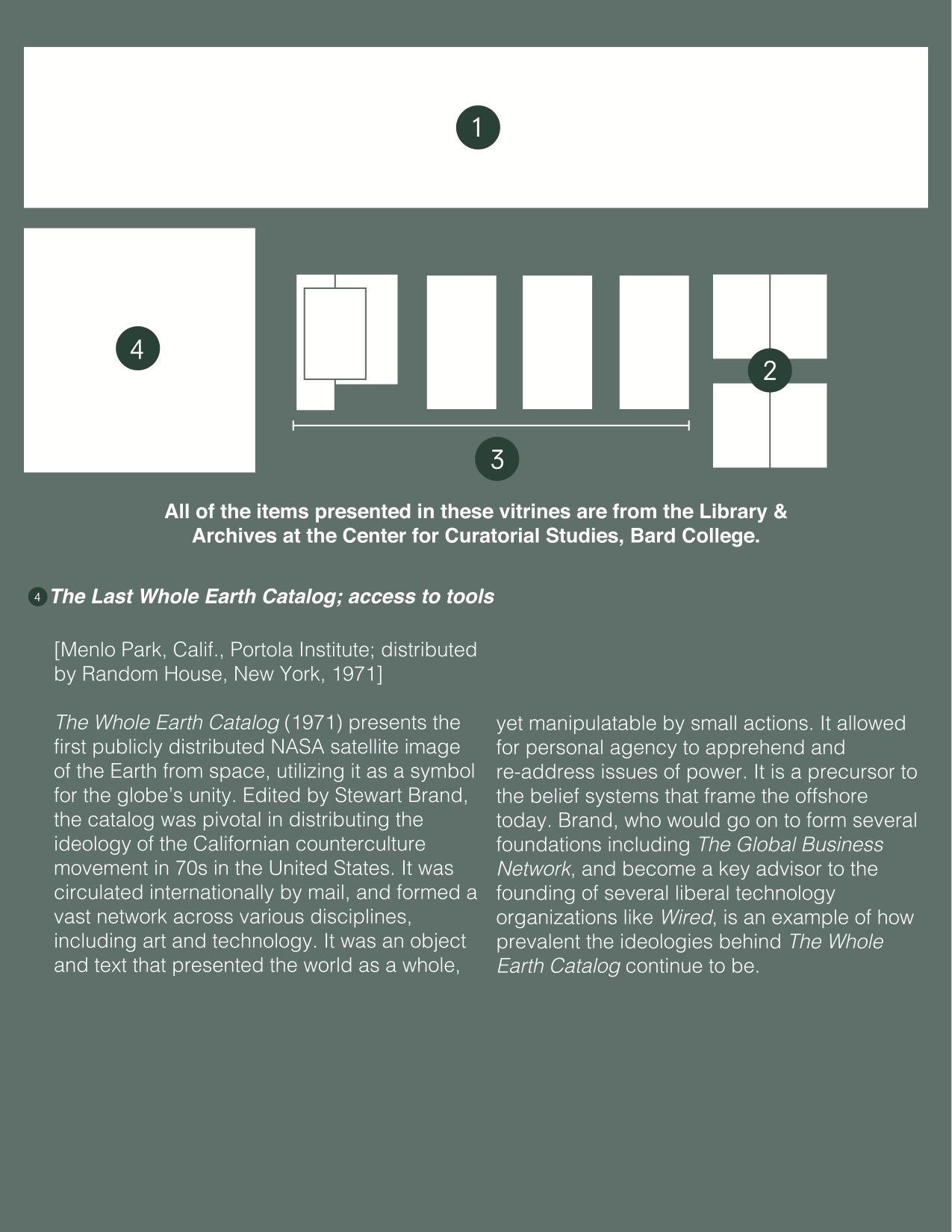
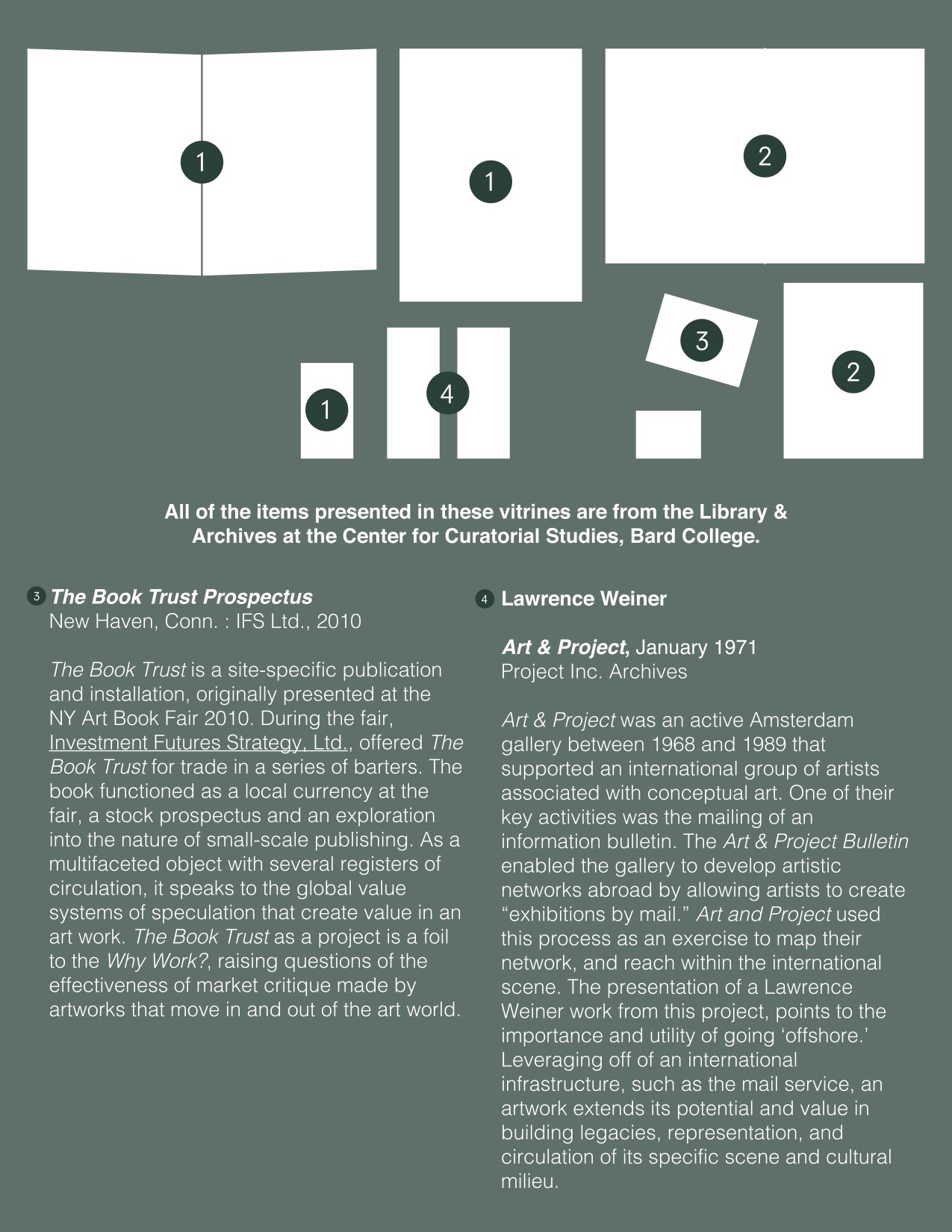
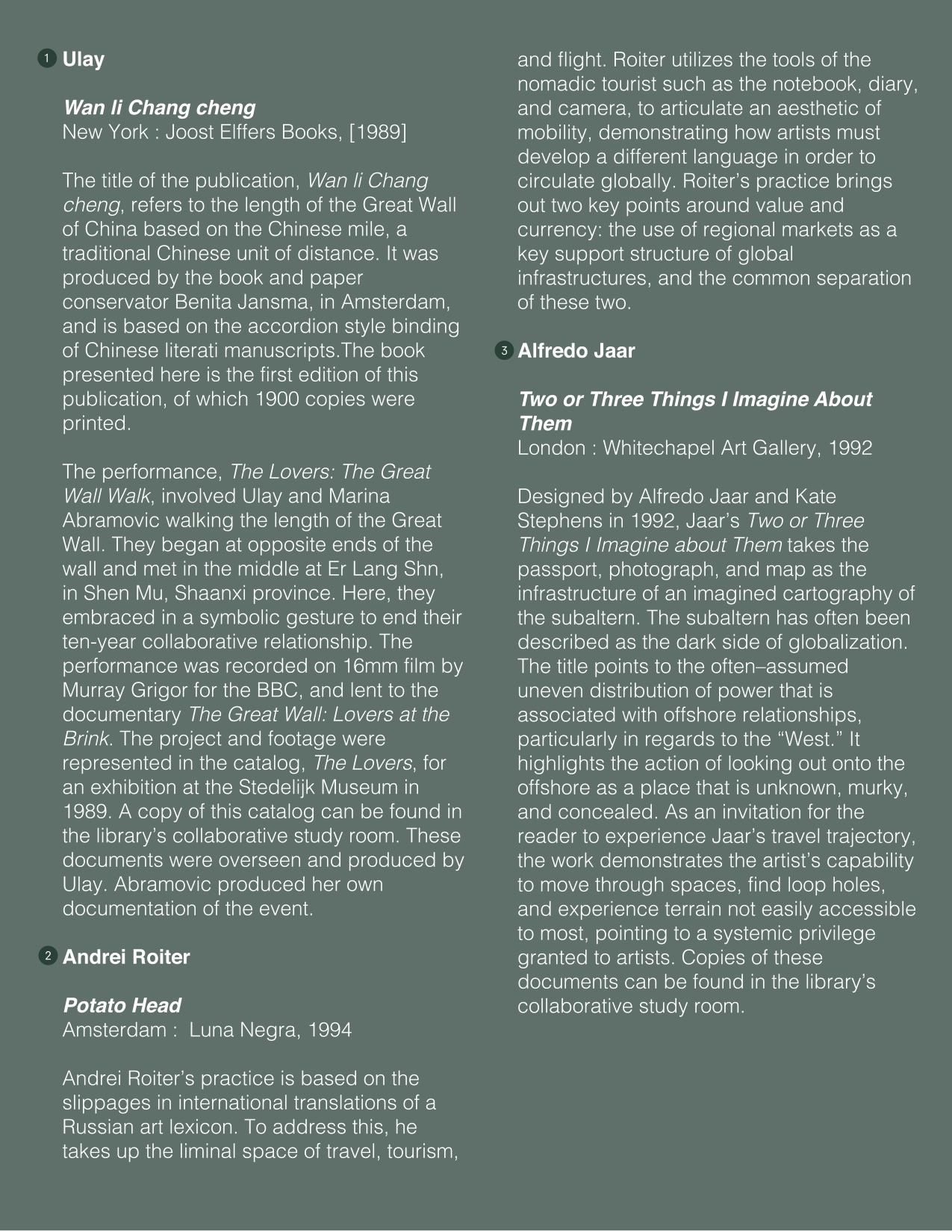
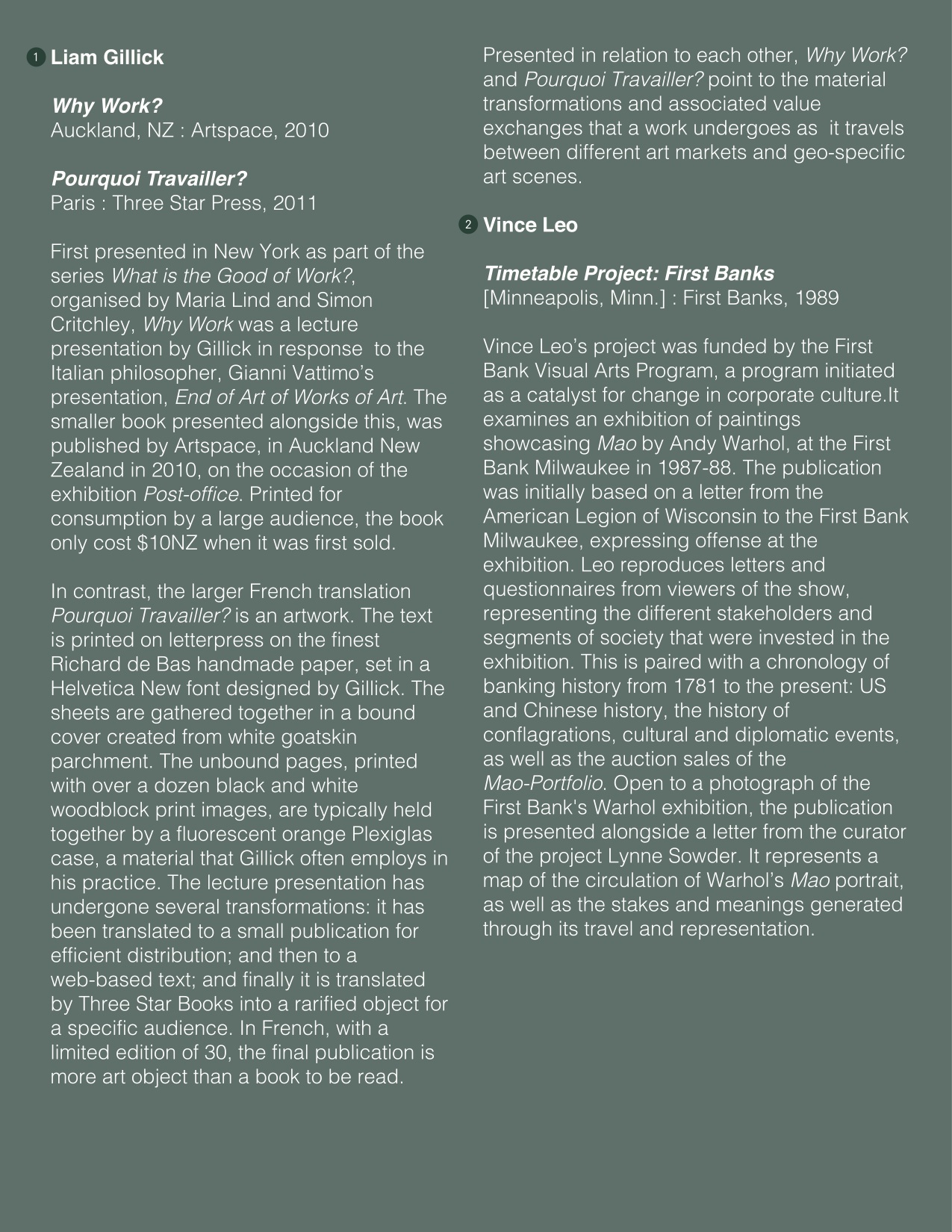
“Roundtripping” is a financial strategy in which capital goes from a central source to a foreign jurisdiction and then returns to the originating country. The strategy is used to distort statistics on foreign direct investment by generating overly optimistic assessments of an economy’s vitality. The items selected in Roundtripping have all undertaken similar complete circuits, but in the art world. The ‘original’ work - for example, a lecture by Liam Gillick, or a performance by Ulay and Marina Abramović - is in each case transformed by the process of travel, effectively aping the global influence of the work. Roundtripping presents works that crystallise the process of generating cultural capital through travel.
Defined by movement, relocation, and concealment, the offshore is an articulated pattern in contemporary economic, social, and political life that influences art circulation and value.
Defined by movement, relocation, and concealment, the offshore is an articulated pattern in contemporary economic, social, and political life that influences art circulation and value.
On Sweat, Paper and Porcelain
March 29 – May 3, 2015, Center for Curatorial Studies, Bard College
With work by Heman Chong, Ho Rui An, The Propeller Group and Superflex,
Andrew Norman Wilson and Akhil C, and Yee I-Lann
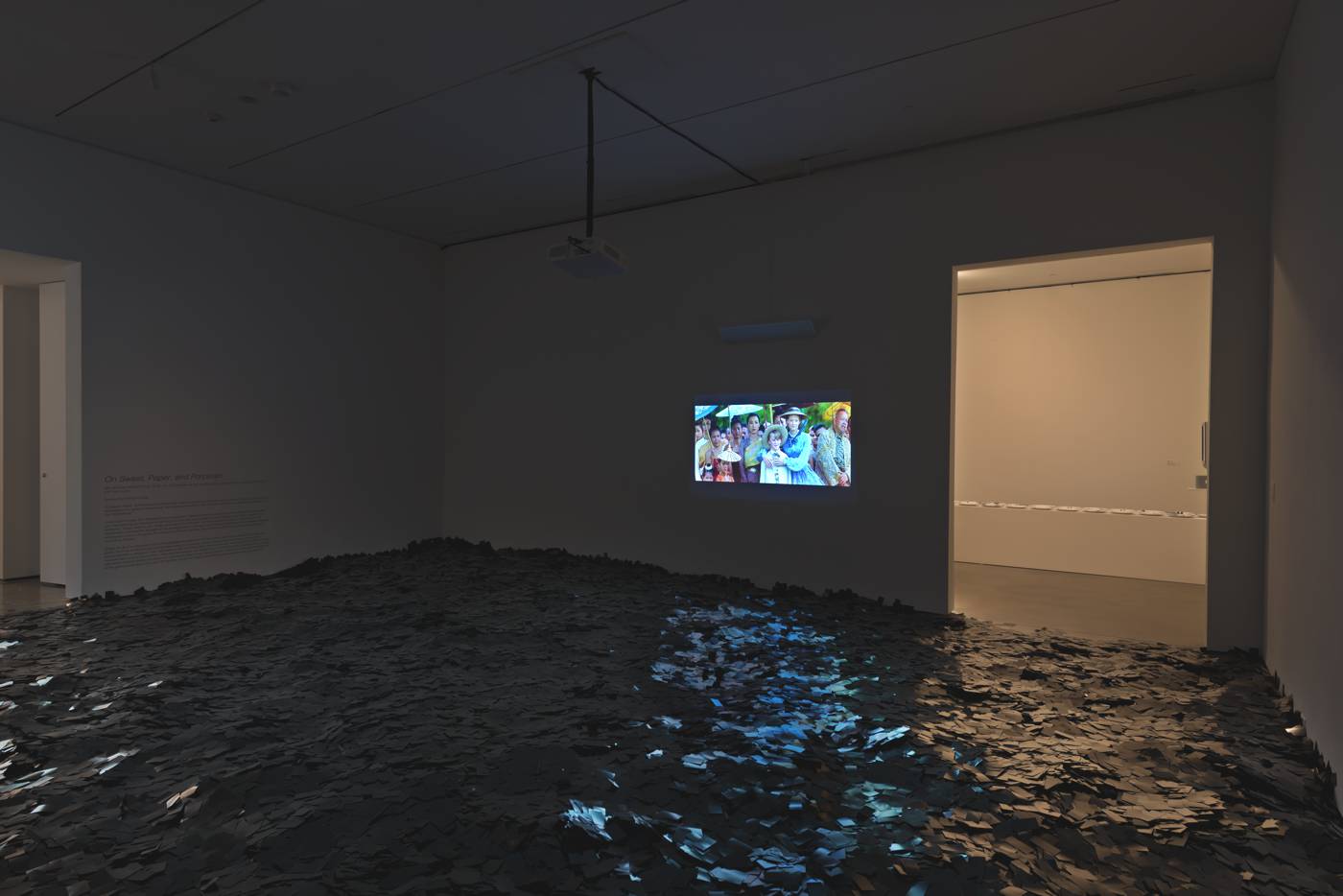
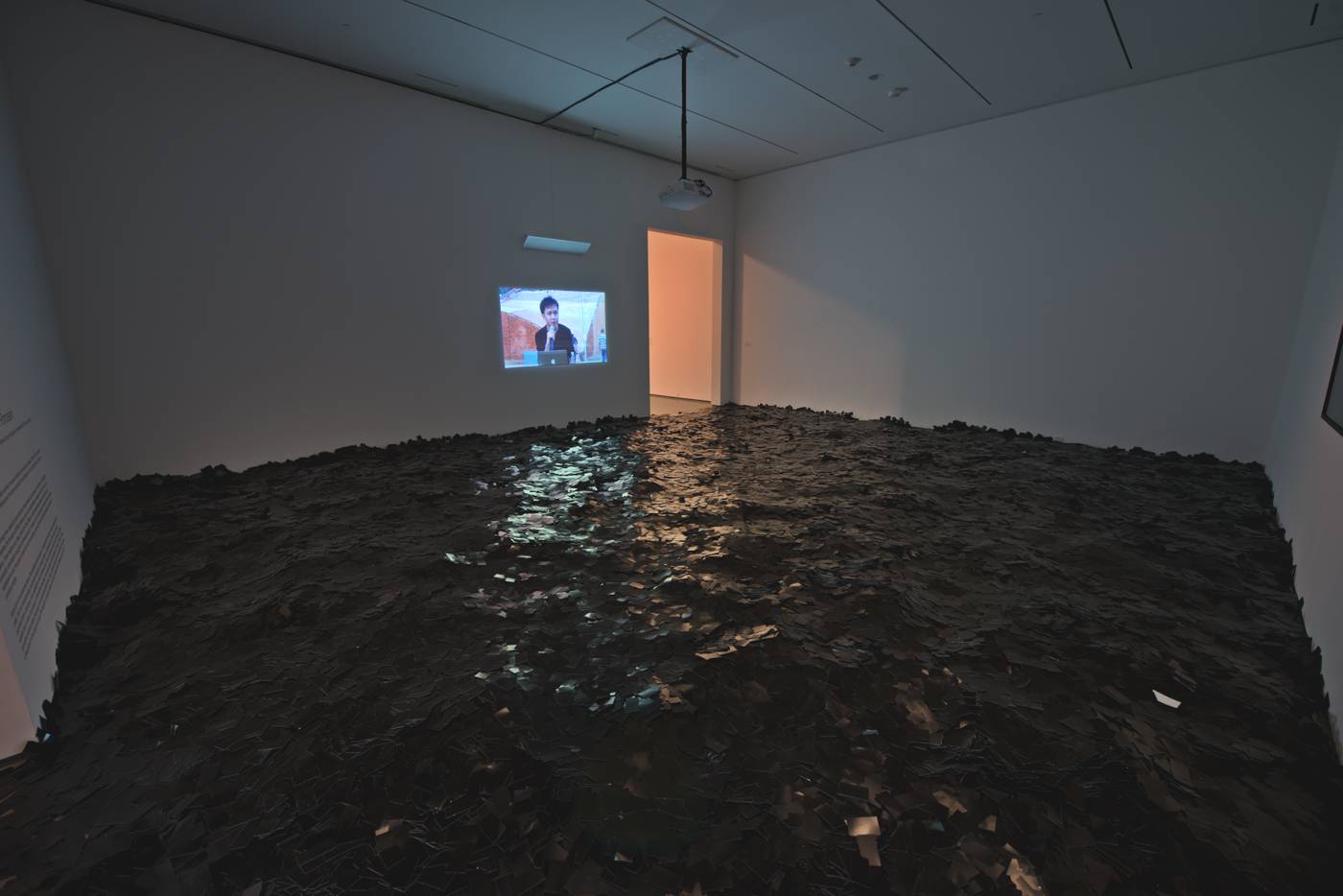
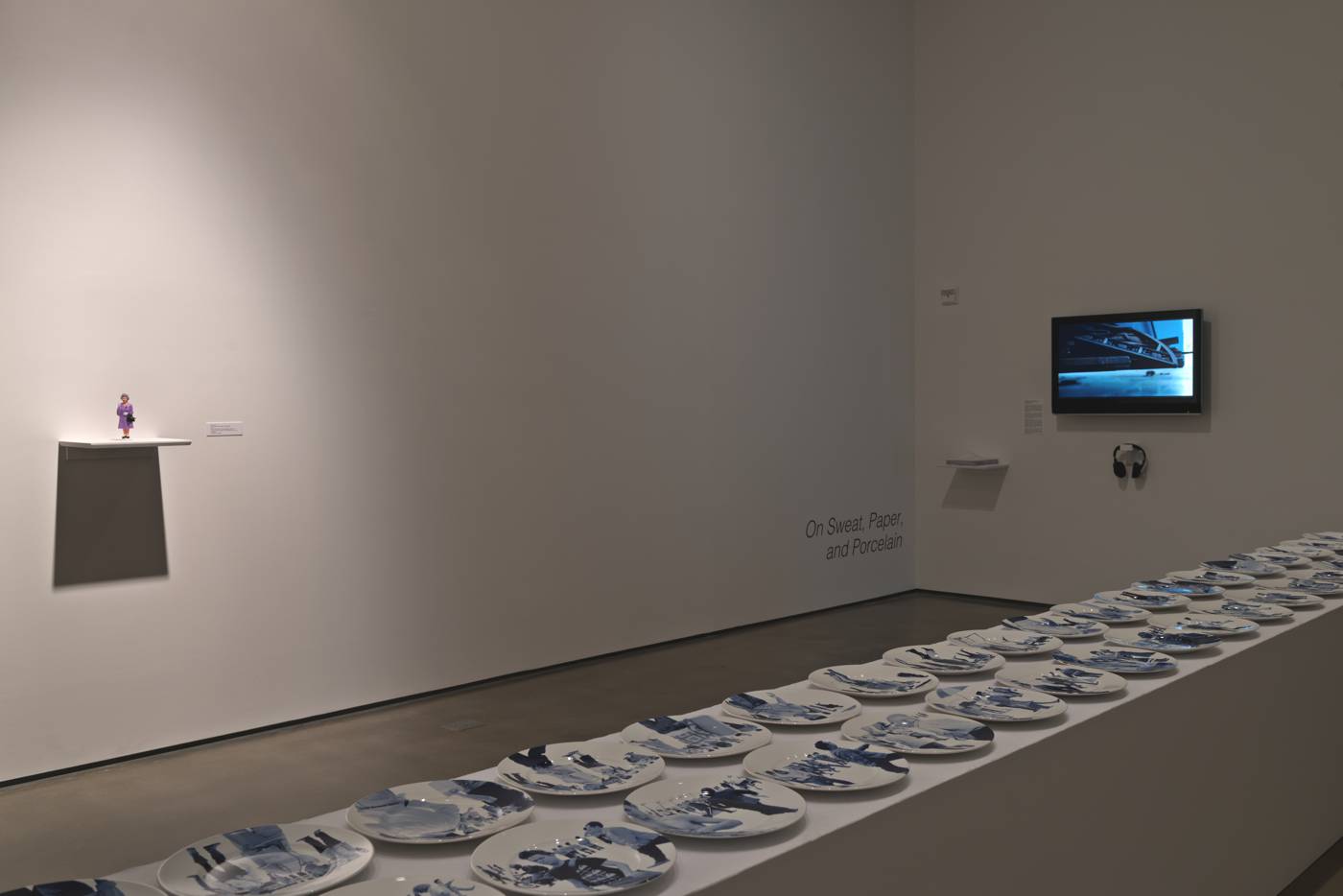
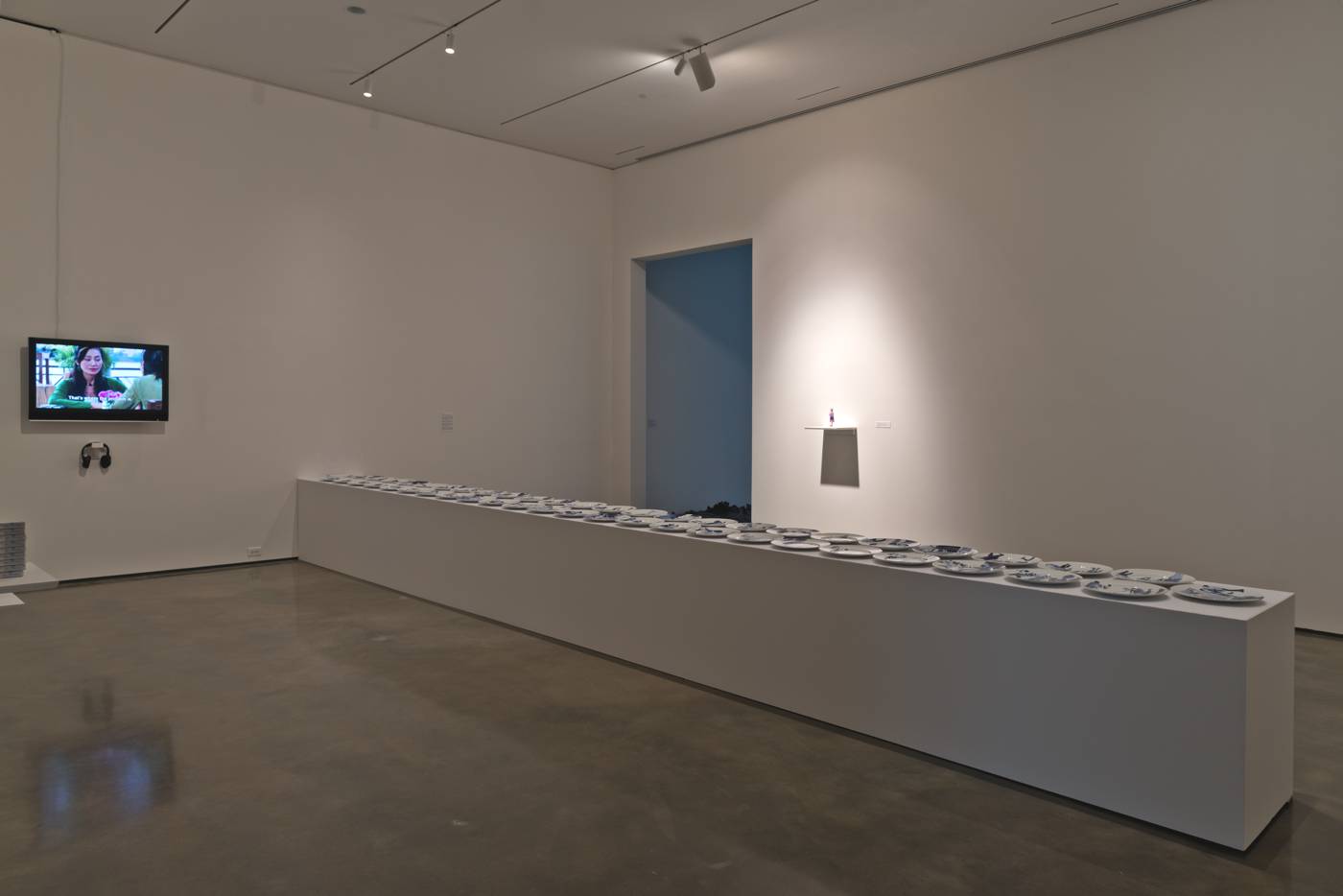
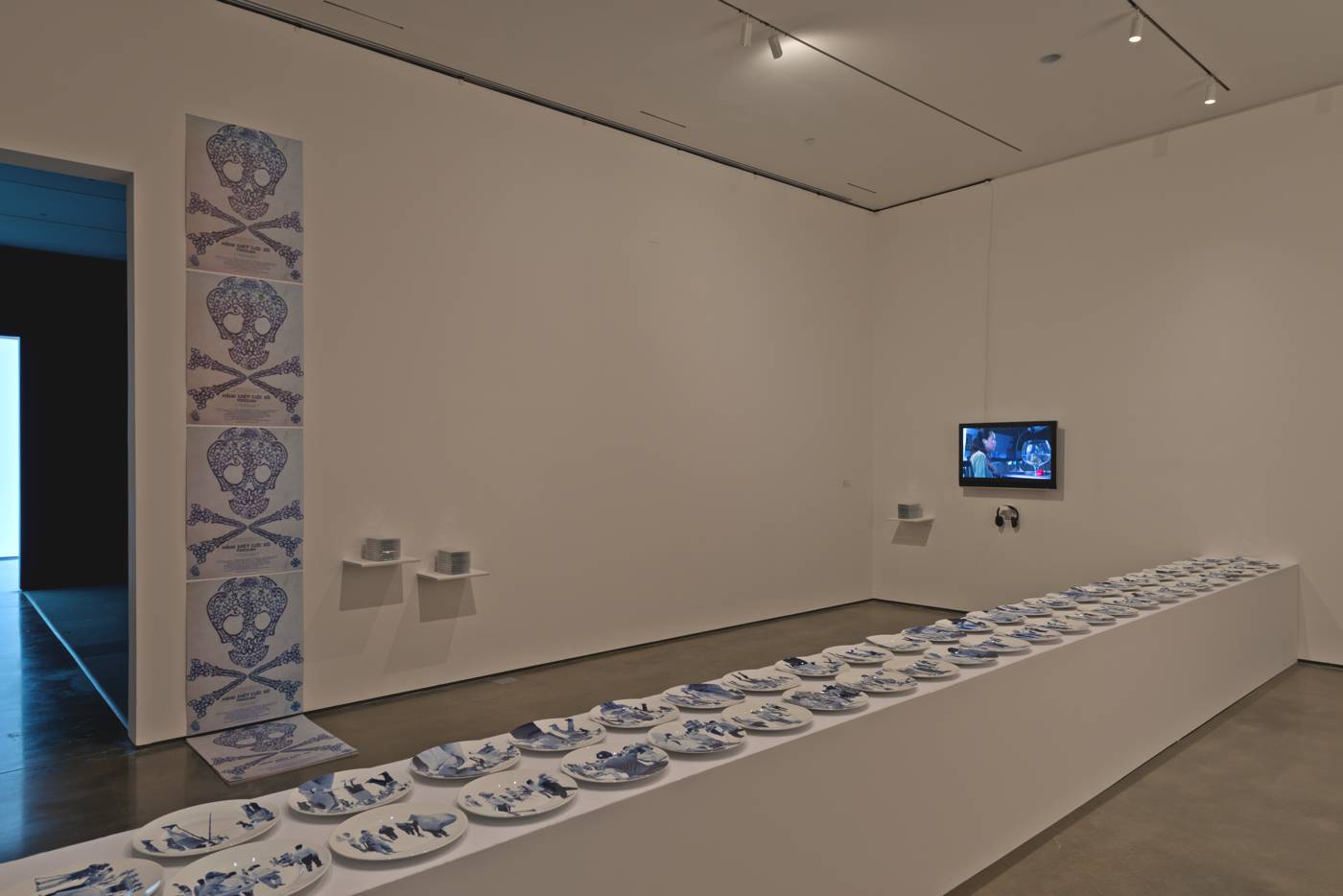
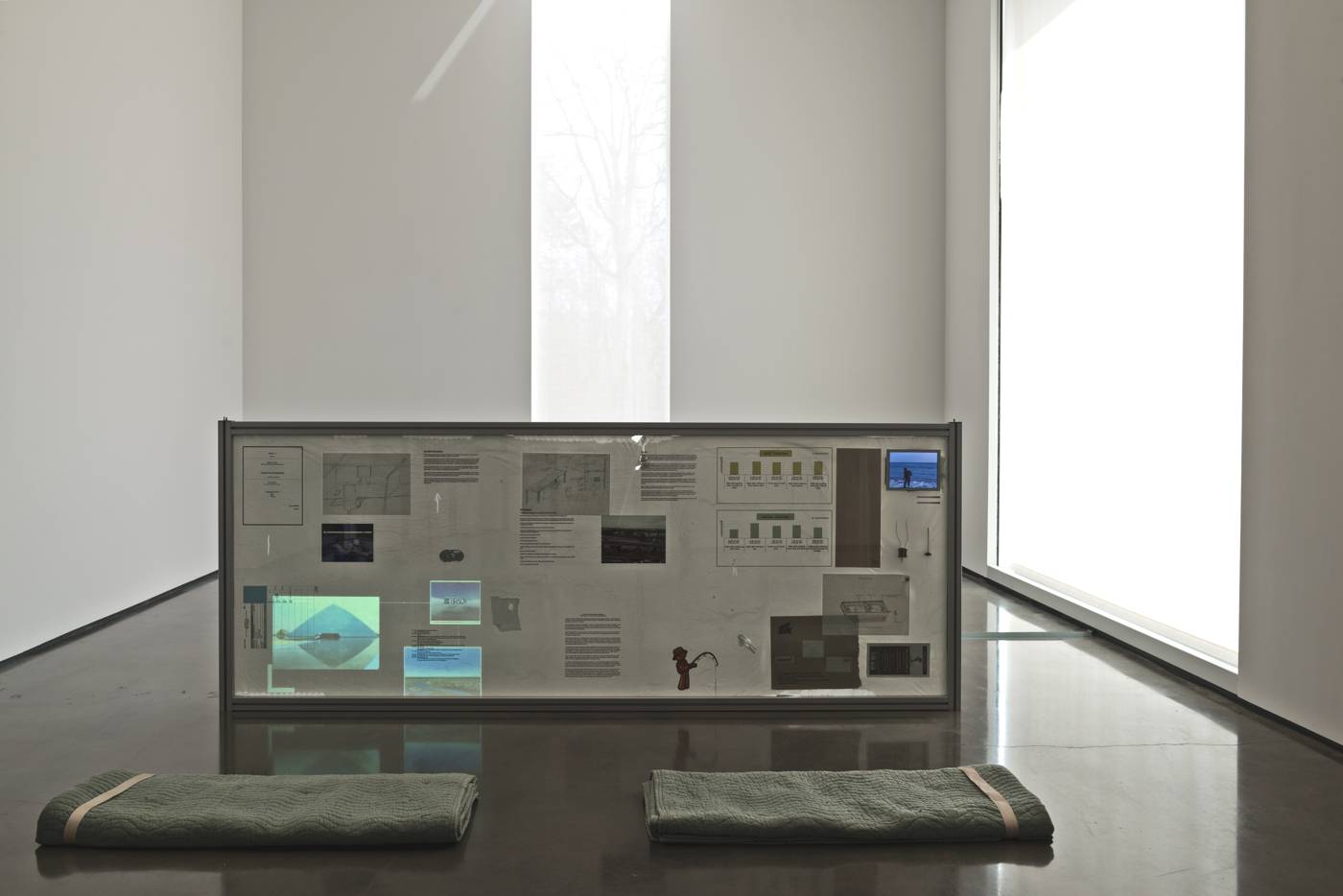
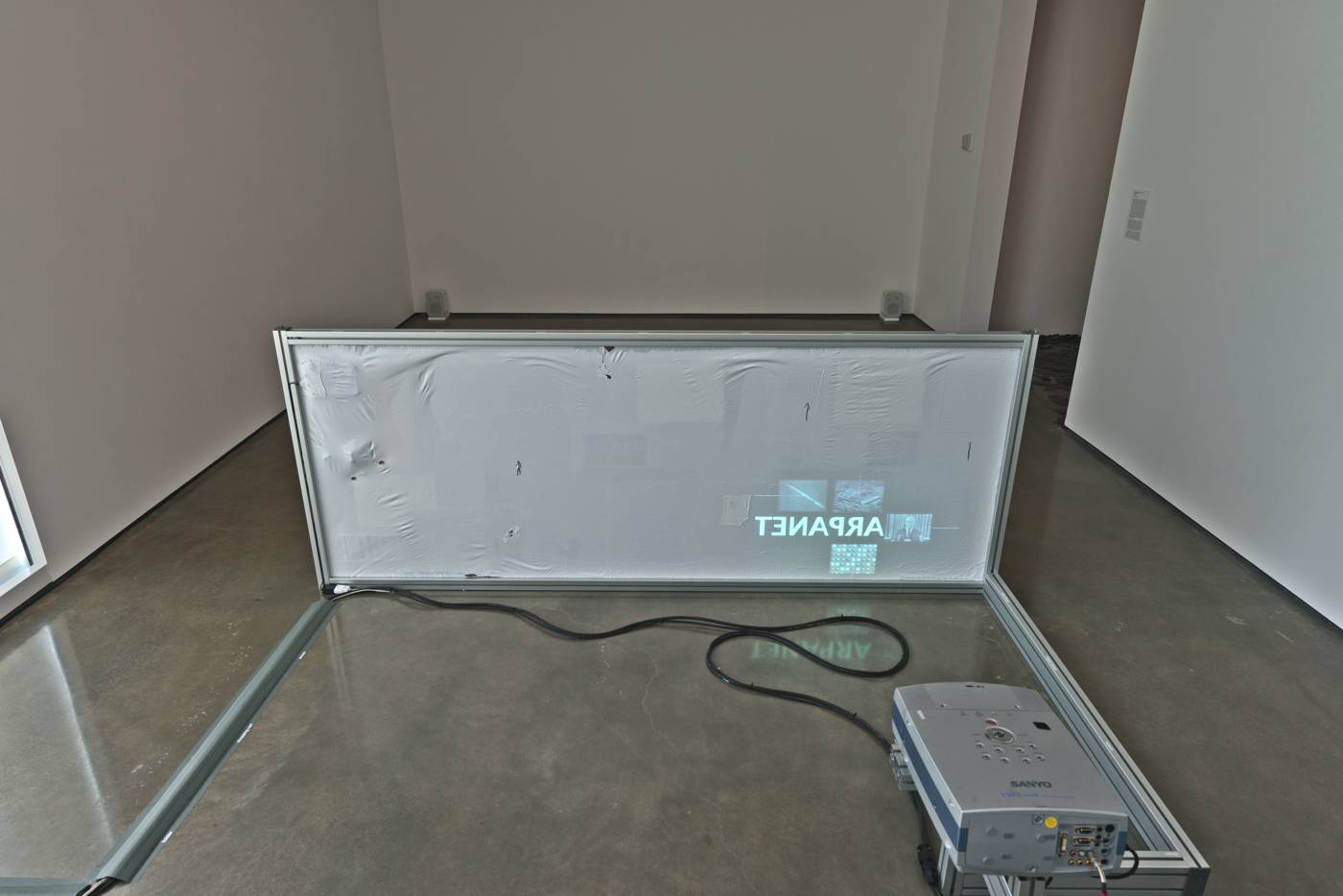
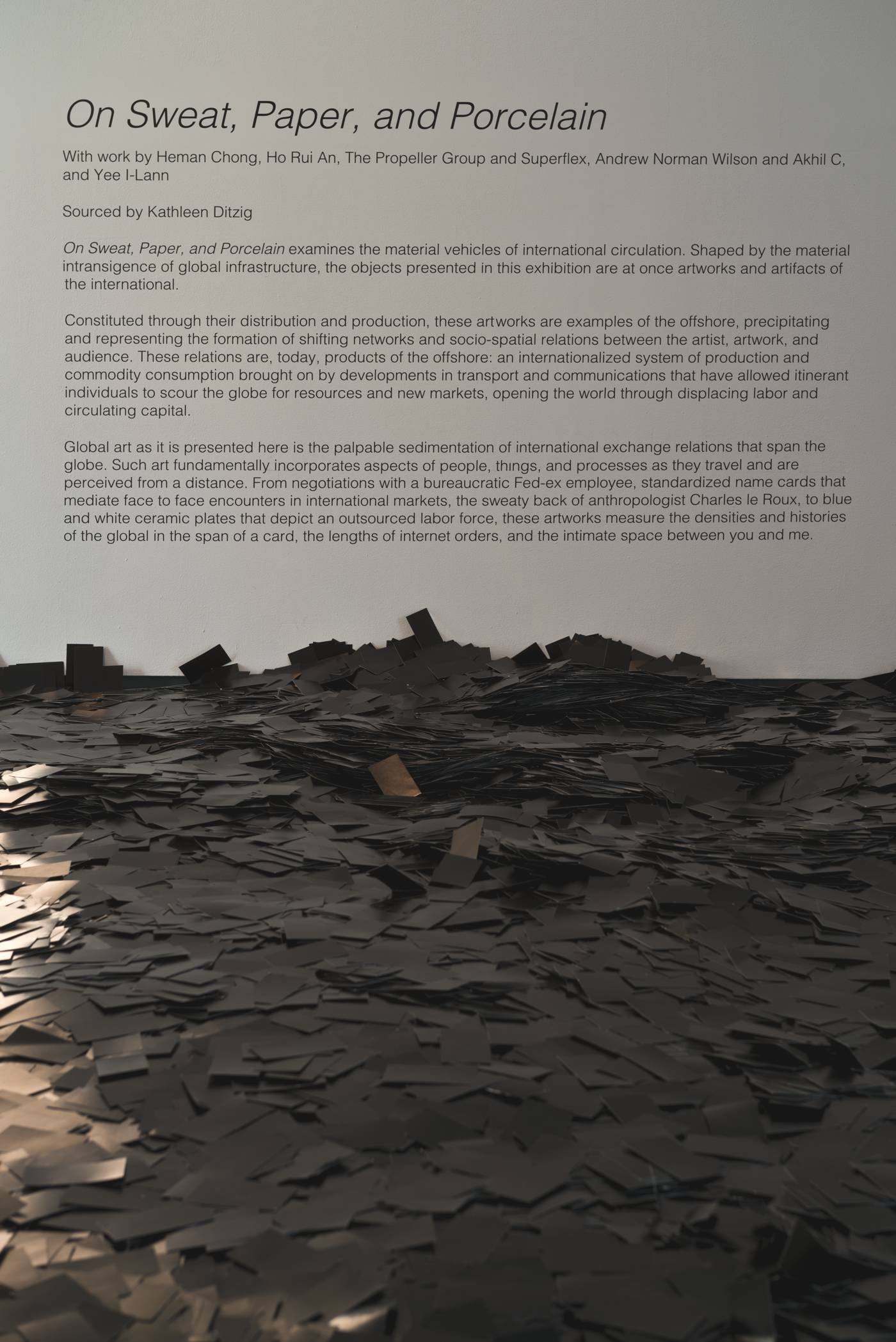
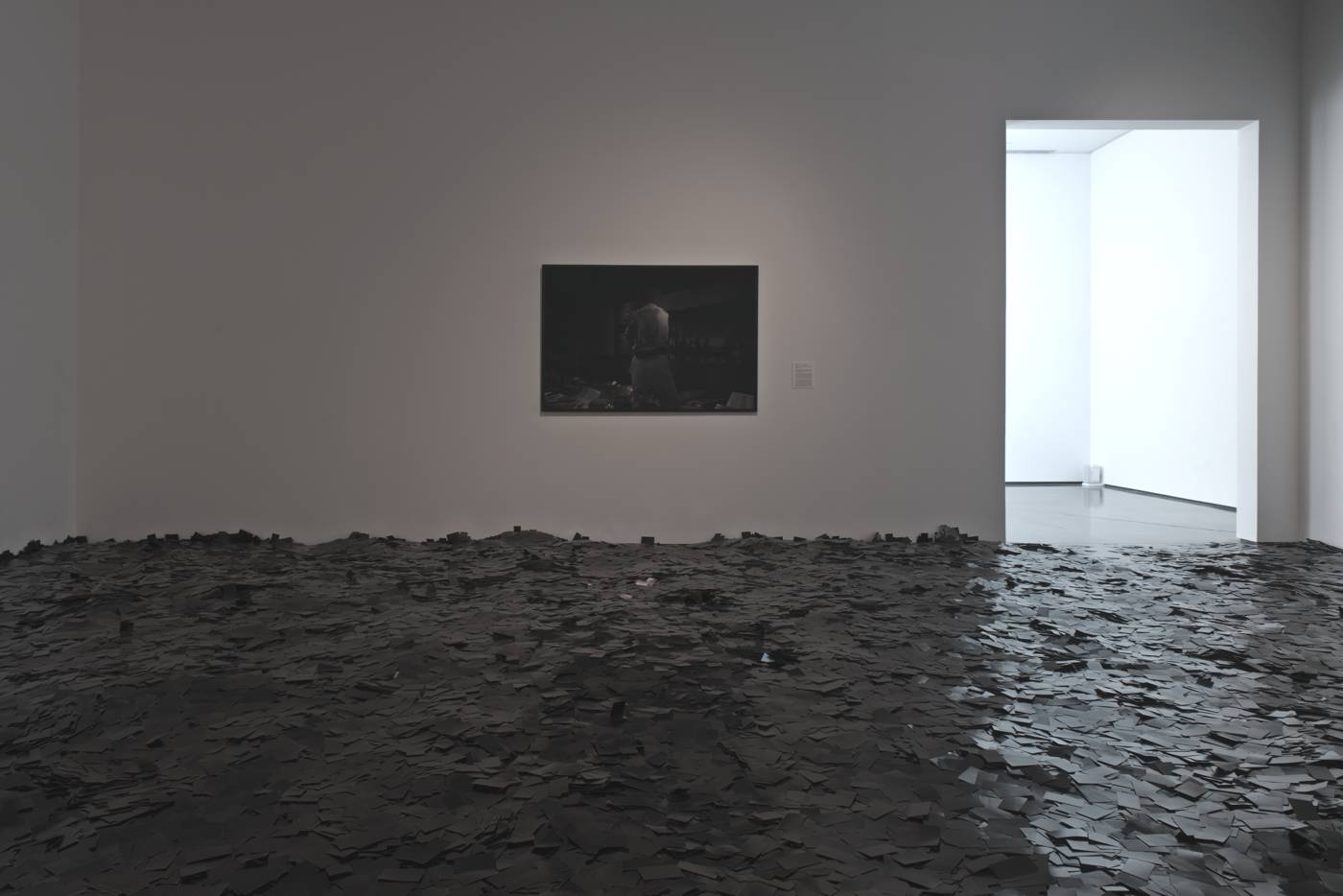
Installation view from On Sweat, Paper, and Porcelain, Center for Curatorial Studies, Bard College, Annandale-on-Hudson, NY, March 29 - May 3, 2015. Master’s thesis exhibition curated by Kathleen Ditzig. Photo: Chris Kendall 2015.
On Sweat, Paper, and Porcelain examines the material vehicles of international circulation. Shaped by the material intransigence of global infrastructure, the objects presented in the exhibition are at once artworks and artifacts of the international.
Constituted through their distribution and production, these examples of the offshore, precipitate and represent the shifting networks and socio-spatial relations between the artist, artwork, and its audience. These relations are, today, products of the offshore: an internationalized system of production and commodity consumption brought on by developments in transport and communications that have allowed itinerant individuals to scour the globe for resources and new markets, opening the world through displacing labor and circulating capital.
Global art as it is presented here is the palpable sedimentation of international exchange relations that span the globe. Such art fundamentally incorporate aspects of people, things, and processes as they travel and are perceived from a distance. From negotiations with a bureaucratic Fed-ex employee, standardized name cards that mediate face to face encounters in international markets, the sweaty back of anthropologist Charles le Roux, to blue and white ceramic plates that depict an outsourced labor force, these artworks measure the densities and histories of the global in the span of a card, the lengths of internet orders, and the intimate space between you and me.
Constituted through their distribution and production, these examples of the offshore, precipitate and represent the shifting networks and socio-spatial relations between the artist, artwork, and its audience. These relations are, today, products of the offshore: an internationalized system of production and commodity consumption brought on by developments in transport and communications that have allowed itinerant individuals to scour the globe for resources and new markets, opening the world through displacing labor and circulating capital.
Global art as it is presented here is the palpable sedimentation of international exchange relations that span the globe. Such art fundamentally incorporate aspects of people, things, and processes as they travel and are perceived from a distance. From negotiations with a bureaucratic Fed-ex employee, standardized name cards that mediate face to face encounters in international markets, the sweaty back of anthropologist Charles le Roux, to blue and white ceramic plates that depict an outsourced labor force, these artworks measure the densities and histories of the global in the span of a card, the lengths of internet orders, and the intimate space between you and me.
Incorporate Me
March 29 – May 3, 2015, Center for Curatorial Studies, Bard College
With work by Heman Chong, Ho Rui An, The Propeller Group and Superflex,
Andrew Norman Wilson and Akhil C, and Yee I-Lann
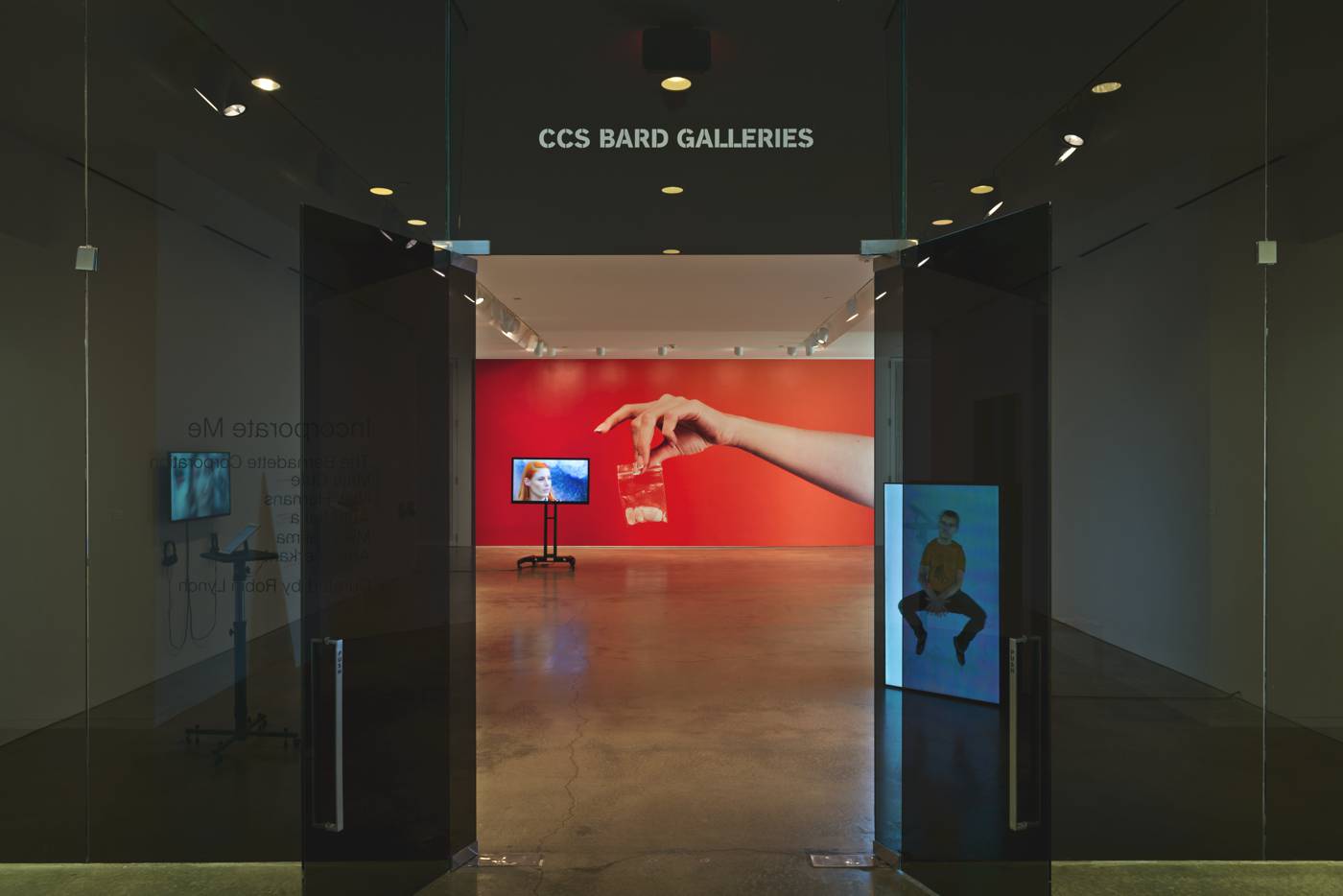
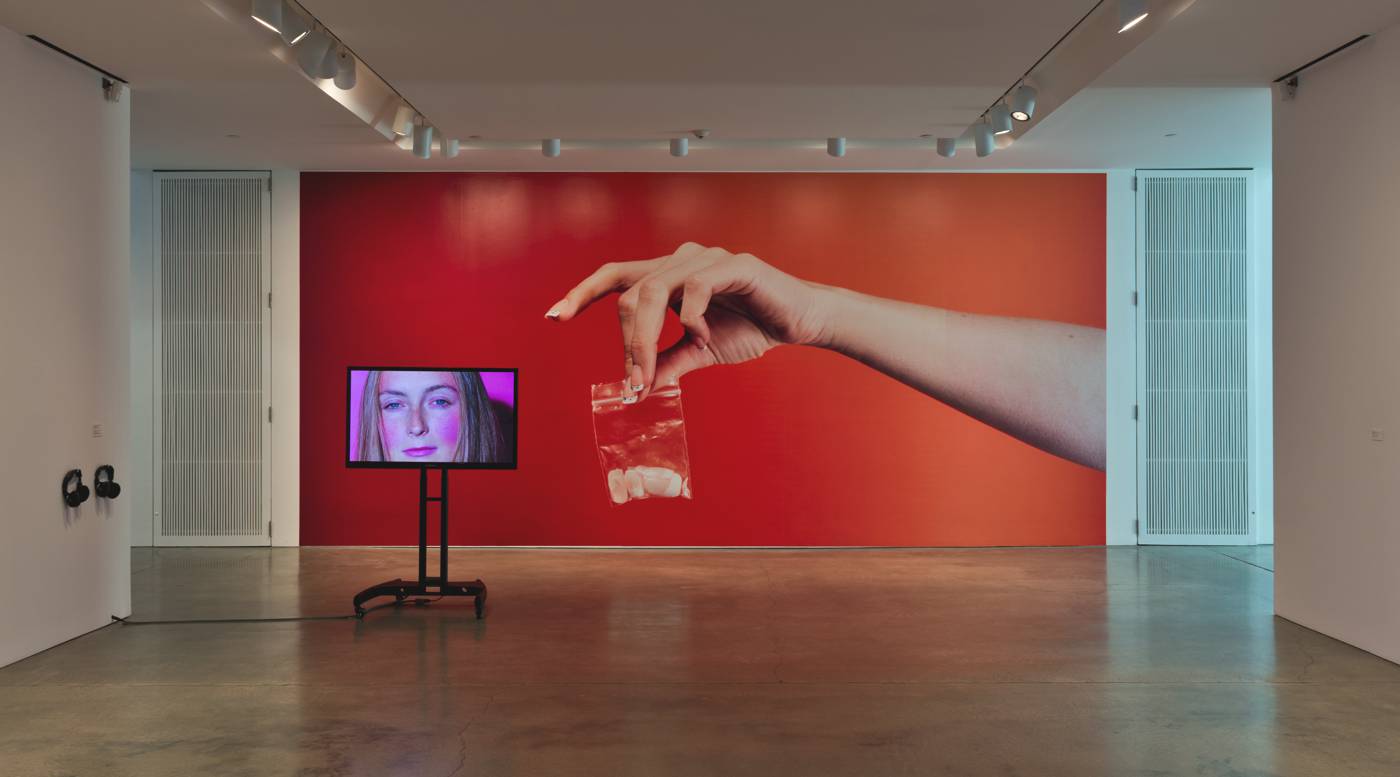
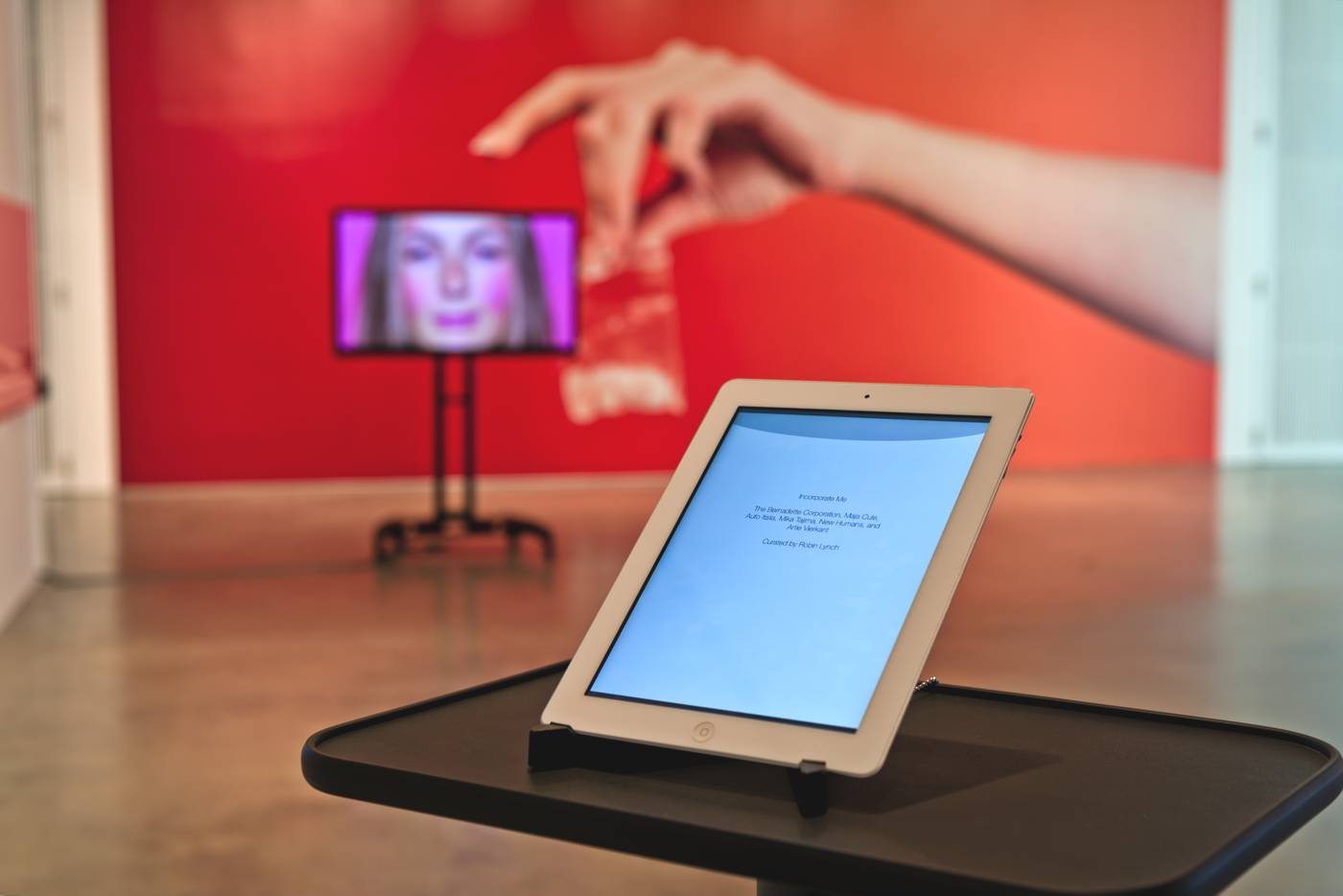
With work by The Bernadette Corporation, Maja Cule, Auto Italia (Kate Cooper, Marianne Forrest,
Marleen Boschen, Andrew Kerton and Jess Wiesner), Mika Tajima, New Humans, and Artie Vierkant. Curated by Robin Lynch.
Digital environments produce highly personalized and familiar experiences, conditioned by individual interests and connections, but also by the platform’s interests that seek to maintain attention. All aspects of the self are exposed for incorporation into the private entities that maintain the infrastructure of technological devices, driven by the users themselves, as they navigate this network. In this way a data portrait portrays not only the individual, but also a conglomeration of other voices, relationships, people, and entities. This tension between hyper-individualism and continuous contact propels a necessity to self-examine, self-represent, self-market, and self-preserve, bringing about paranoid impulses to maximize yourself, and be the best possible you.
Analyzed through the lens of its corporate interests, Web 2.0 becomes a medium for the further collapse of time between work and life, and the incorporation of individual subjecthood for the sake of market productivity. The increasing need for self-representation of one’s own livelihood, coupled with the rise of “prosumers” and do-it-yourself initiatives, points to the internalization of a corporate mentality in everyday users seeking ways to be included. Together the private and individual needs feed off of one another, co-opting bits of each other’s strategies, networks, and resources in order to bolster their own experience, capital, reach, and representation.
The tumultuous and rapid exchange of information, data, messages, tabs, ads, websites, links, likes, and new applications obscures and confuses the numbers of entities involved, who is co-opting whom, and the inherent biases and interests which condition these movements. Here, ownership becomes an ambiguous and slippery term, as a constant struggle of co-optation, incorporation, autonomy, and contractual clauses compete and confound one another. The increasingly large number of entities involved in this interaction vying to carve out their own space and representation contribute to the creation of an invasive attention economy. Incorporate Me brings together works that investigate the tensions, complex hierarchies, and strategies involved in these networked economies, bringing to light both the benefits and constrictions of operating in a continuously connected environment.
Marleen Boschen, Andrew Kerton and Jess Wiesner), Mika Tajima, New Humans, and Artie Vierkant. Curated by Robin Lynch.
Digital environments produce highly personalized and familiar experiences, conditioned by individual interests and connections, but also by the platform’s interests that seek to maintain attention. All aspects of the self are exposed for incorporation into the private entities that maintain the infrastructure of technological devices, driven by the users themselves, as they navigate this network. In this way a data portrait portrays not only the individual, but also a conglomeration of other voices, relationships, people, and entities. This tension between hyper-individualism and continuous contact propels a necessity to self-examine, self-represent, self-market, and self-preserve, bringing about paranoid impulses to maximize yourself, and be the best possible you.
Analyzed through the lens of its corporate interests, Web 2.0 becomes a medium for the further collapse of time between work and life, and the incorporation of individual subjecthood for the sake of market productivity. The increasing need for self-representation of one’s own livelihood, coupled with the rise of “prosumers” and do-it-yourself initiatives, points to the internalization of a corporate mentality in everyday users seeking ways to be included. Together the private and individual needs feed off of one another, co-opting bits of each other’s strategies, networks, and resources in order to bolster their own experience, capital, reach, and representation.
The tumultuous and rapid exchange of information, data, messages, tabs, ads, websites, links, likes, and new applications obscures and confuses the numbers of entities involved, who is co-opting whom, and the inherent biases and interests which condition these movements. Here, ownership becomes an ambiguous and slippery term, as a constant struggle of co-optation, incorporation, autonomy, and contractual clauses compete and confound one another. The increasingly large number of entities involved in this interaction vying to carve out their own space and representation contribute to the creation of an invasive attention economy. Incorporate Me brings together works that investigate the tensions, complex hierarchies, and strategies involved in these networked economies, bringing to light both the benefits and constrictions of operating in a continuously connected environment.
SINGAPORE
Presentation: 'Freeports, the Art World and Virtual Proxies’
Grey Projects, 19 October 2015
The Singapore Freeport as Schrödinger’s Cat Freeport As Art City As Imagined Regional Market
Asia Research Institute (ARI) Conference, 17-18 March 2016
ART CAPITAL Reading Group
With the completion of its first iteration at CCS bard, offshoreart.co travelled to a different offshore (mid-shore) jurisdiction. As the first moment of in-depth country specific research, offshoreart.co explored Singapore as a mid-shore/offshore jurisdiction for the international art market. In a recent article by Hito Steyerl, titled “Duty-Free Art,” Steyerl included a section on the major freeport in Singapore, which opened in 2009. Steyerl described this zone as one of the “prime spaces for contemporary art” as it functions as “an offshore or extraterritorial museum.” The freeport becomes a space which appears to be extra-state, allowing for the sheltering of valuable artworks from taxation through a cloudy line in jurisdictions. However, it nonetheless still functions as a vital point for bringing in capital and traffic into Singapore from the international community.
Shifting the lens of Singapore’s inclusion in the international art world away from discourses of difference and multi-cultural inclusion to the infrastructure and services that it provides the (art)world, offshoreart.co is based in Singapore from 2015-2016 to investigate such infrastructure of the offshore as the Freeport as a tactical nexus point for market and regional development.
In partnership with Grey Projects’ curator-in-residence programme, offshoreart.co developed new research on the Freeport and its role in the construction of a regional Southeast Asian art market.
This research was eventually presented through a series of presentations, lectures, reading groups and published articles.
Shifting the lens of Singapore’s inclusion in the international art world away from discourses of difference and multi-cultural inclusion to the infrastructure and services that it provides the (art)world, offshoreart.co is based in Singapore from 2015-2016 to investigate such infrastructure of the offshore as the Freeport as a tactical nexus point for market and regional development.
In partnership with Grey Projects’ curator-in-residence programme, offshoreart.co developed new research on the Freeport and its role in the construction of a regional Southeast Asian art market.
This research was eventually presented through a series of presentations, lectures, reading groups and published articles.
Presentation: 'Freeports, the Art World and Virtual Proxies'
Singapore’s art infrastructure, namely the Freeport, has positioned Singapore as a pivotal gateway in the global capital and art flows that define the international art market, capturing the imagination of an international art literati. In “Duty-Free Art,” a recent article by Hito Steyerl, Singapore Freeport is described as one of the “prime spaces for contemporary art”. Similarly, Deloitte’s report on Southeast Asia as an emergent art market in 2014 figured Singapore prominently as a financial and art market hub, as well as a key contributing factor to the growth of Southeast Asia as an art market due to its infrastructure.
Despite figuring into frameworks of economic markets and international art discourse, the Singapore Freeport is often left out of the conversation when we talk about what makes Singapore an arts city. An art and private wealth logistics hub, the Singapore Freeport is strategically located within Singapore’s Free Trade Zone, and reaps benefits such as exceptions from import duties, indirect taxes, or security deposits. It has been integral to the expansion of Singapore’s cultural scene, indirectly benefiting art fairs like Art Stage Singapore, and the creation of value chains for the circulation of art, such as being possibly related to the establishment of the Pinacothèque in Singapore.
'Freeports, the Art World and Virtual Proxies' was the first of three public presentations by offshoreart.co. It covered the research threads and questions that offshoreart.co asked through its residency at Grey Projects, and is also an open call for collaborators interested in this project. The presentation concluded with a tour of “Second life”, a project by Debbie Ding that provides an analogy to understanding the culture of the offshore.
Despite figuring into frameworks of economic markets and international art discourse, the Singapore Freeport is often left out of the conversation when we talk about what makes Singapore an arts city. An art and private wealth logistics hub, the Singapore Freeport is strategically located within Singapore’s Free Trade Zone, and reaps benefits such as exceptions from import duties, indirect taxes, or security deposits. It has been integral to the expansion of Singapore’s cultural scene, indirectly benefiting art fairs like Art Stage Singapore, and the creation of value chains for the circulation of art, such as being possibly related to the establishment of the Pinacothèque in Singapore.
'Freeports, the Art World and Virtual Proxies' was the first of three public presentations by offshoreart.co. It covered the research threads and questions that offshoreart.co asked through its residency at Grey Projects, and is also an open call for collaborators interested in this project. The presentation concluded with a tour of “Second life”, a project by Debbie Ding that provides an analogy to understanding the culture of the offshore.
The Singapore Freeport as Schrödinger’s Cat
Freeport As Art City As Imagined Regional Market
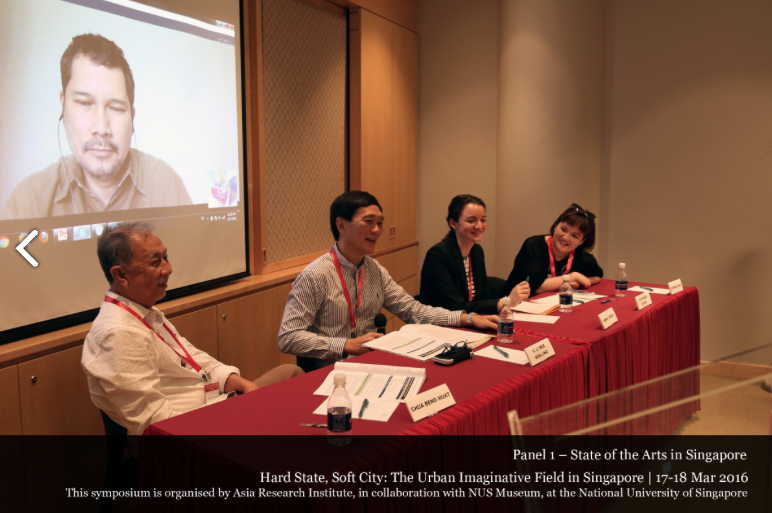
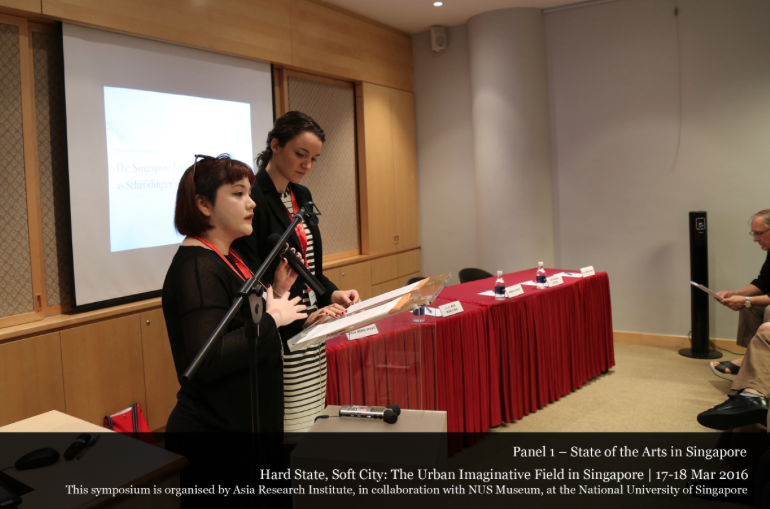
In thinking of Singapore as an arts city, what often gets left out of the conversation despite being integral to it is Singapore’s FreePort. Established in 2010, the Singapore FreePort is a 270,00 square foot facility at the Changi airport logistics park. An art and private wealth logistics hub, strategically located within Singapore’s Free Trade Zone, the Singapore Freeport benefits from being part of a free zone and is largely independent of the political jurisdiction of the country it sits in.
For example, works of art stored at the Freeport can be displayed in Singapore’s museums without import duties, indirect tax or security deposits. Assets (artwork, gold, wines and other valuables) traded at the Freeport similarly are exempt from tax.
While, it benefits from exemptions from Singapore’s taxes, the Freeport is a project deeply ingrained within the Singapore state. The Freeport’s website alone declares that “Singapore rapidly enacted regulations necessary to optimally operate a Freeport”. The Freeport’s day-to-day operations are made possible because of the support of the Singapore customs, the Singapore police, the Civil aviation authority and the Economic Development Board. Furthermore,at the time of its establishment the National Arts Council and the National Heritage Board each held a 5% stake in the corporation. Thus, despite being outside of the jurisdictions of Singapore, it is inherently a project of the Singapore state.
In this regard, the FreePort addresses two parts of Singapore’s development and sustainability strategy a) to become a regional arts hub and b) to be a global center for wealth management. The FreePort was exemplary of the goals of the Renaissance City Plans and benefited from Singapore’s 2002 raft of laws that bolstered banking secrecy and strengthening of trusts.At the Singapore FreePort’s official opening in 2010, the then Senior Minister of State for Trade & Industry and Education Mr S Iswaran noted that more investors were choosing to put their money in high-value “investments of passion”, such as fine art. With Singapore’s strategic location, infrastructure and ties to markets in Asia, he further said that “Singapore is an ideal location for companies seeking to tap into the arts and collectibles trade in the region.” The Freeport in this vein would help fuel the development of creative industries in Singapore, and strengthen its role as a global arts hub.
To date, it has been shown to be successful in such endeavours. Designed by Swiss architects, engineers and security experts, the FreePort building has captured a international imaginary of Singapore as an art city and conduit to Southeast Asia. It has been dubbed by artist-theorists such as Hito Steyerl, the future of private art museums and is often the lens by which the internationalism of Singapore art scene is framed. For example, in Deloitte’s 2014 survey of art markets, Singapore’s infrastructure was denoted as a definitive frame for Southeast Asia as an emergent art market. Furthermore, the FreePort has lent to the internationalisation of Singapore’s cultural scene, with the establishment of the Pinacotheque at Fort canning, which was also achieved through generous state subsidy. The founder of the Freeport, Yves Bouvier is directly tied to the development of the museum at Fort canning, as part the company Art Heritage Singapore, which looks over the museum and of which he is a founding partner. This speaks to the creation of a value chain for the circulation and presentation of art in Singapore that stems from the FreePort.
This paper will focus on the Singapore’s Freeport and its associated development of Singapore’s cultural scene, particularly the definition of Singapore as an international or regional art depot. Presenting the research of the curatorial collective offshoreart.co, the paper will present the practical outcomes of the representation of Singapore vis a vis the FreePort in terms of creative production within Singapore and the development of a value chain for the flow of art/capital assets through the island-city. The paper will attempt to ask if Singapore’s working art scene benefits from a trickle down of wealth and opportunity from this state enabled infrastructure, The paper will also discuss the international case of fraud placed against Yves Bouvier on accounts of overpricing artworks, the representation of Singapore as a city-state in how it legally addressed the international case and what it tells us about Singapore as an international art scene.
Art Capital Reading Group
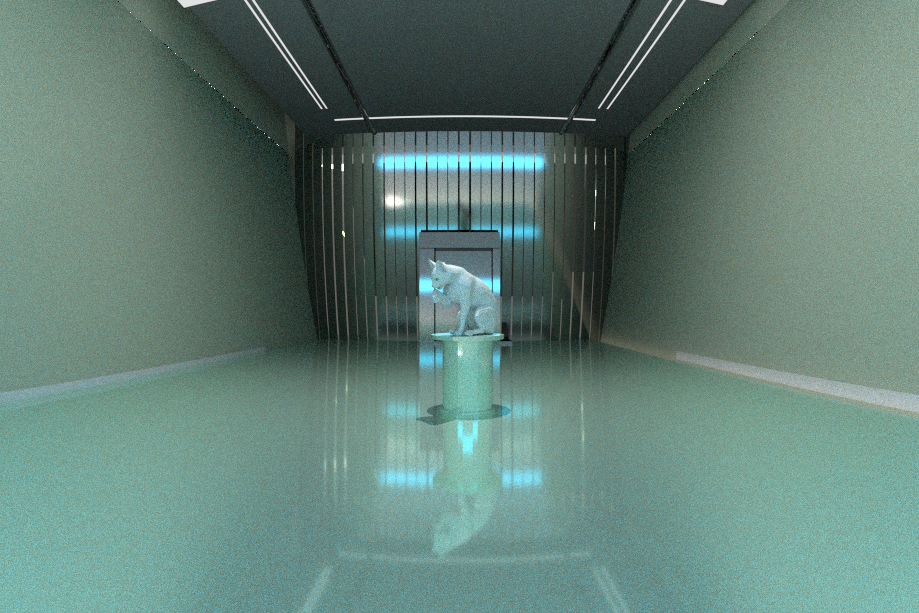
1. Art Capital is the first reading group organised by offshoreart.co in Singapore.
2. In forming a reading community that will discuss capital, the offshore, art, creative industries and visualising the complex networks and relations that bring these things together, we seek a vocabulary for the conditions that define art today.
3. In so doing, this will be our concerted effort to figure out what global structures such as international art market(s), biennials and global creative cities, do to art, in terms of how it is valued and circulated.
All are welcome
ABOUT
Organized by Robin Lynch, Kathleen Ditzig and Debbie Ding, OFFSHOREART.CO is a platform that thinks through offshore economies as a way of understanding global infrastructures and the narratives that support them. Often used with respect to foreign banks, corporations, investments and deposits, offshore is a concept that underpins the institutional life of exchange in our current era of globalism. Frequently a privileged structure of 'otherness', it can speak to an independent legal, political zone or outlying subsidiary of the state that addresses deficiencies in centers of power.
Defined by movement, relocation and concealment, the offshore is an articulated pattern in contemporary economic, social and political life. Within the frame of the CCS Bard graduate program, offshoreart.co identifies the art world and curatorial discourse generally as one such 'offshore economy'. This first iteration of the project includes this website, Roundtripping, a project at CCS Bard, and two Google+ hosted conferences on 29th and 30th April 2015 from 3 to 5pm EST.
If you would like to contact offshoreart.co, please email us at offshoreartco@gmail.com
If you would like to contact offshoreart.co, please email us at offshoreartco@gmail.com